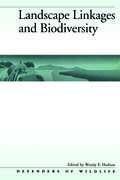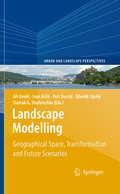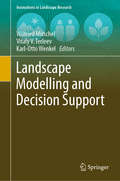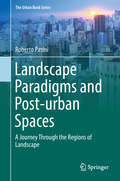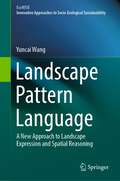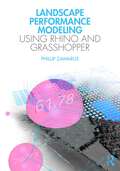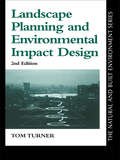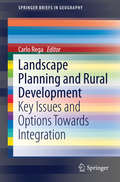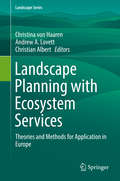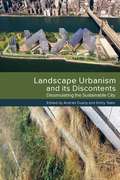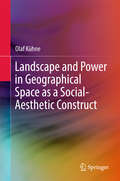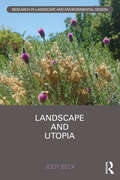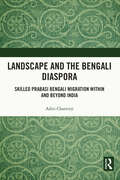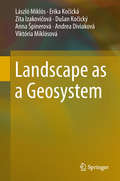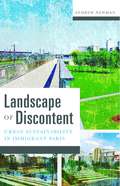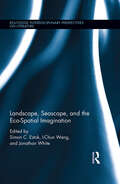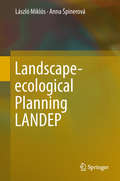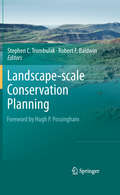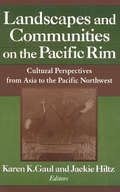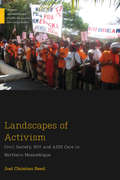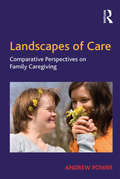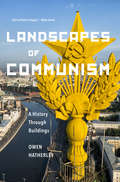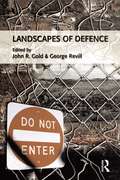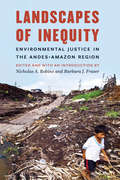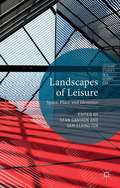- Table View
- List View
Landscape Linkages and Biodiversity: Policies For A Sustainable Future
by Larry Harris Michael E. Soulé J. Michael Scott Wendy E. Hudson Blair Csuti Keith HayIn Landscape Linkages and Biodiversity experts explain biological diversity conservation, focusing on the need for protecting large areas of the most diverse ecosystems, and connecting those ecosystems with land corridors to allow species to move among them more easily.
Landscape Modelling
by Siamak G. Shahneshin Ivan Bičík Jiří Anděl Petr Dostál Zdeněk LipskýLandscape modelling integrates the differing perspectives of the many disciplines that deal with the landscape. It is motivated not only by the desire for scientific understanding, but also by the real-time demands of 21st century postindustrial society, which include the twin imperatives of stabilizing damaged ecosystems on the one hand, and finding effective ways to use the landscape on the other. The discipline has the specific goal of designing and assessing future scenarios of landscape development, while not losing sight of its past history, both ecological and socio-cultural. This book encompasses the interrelated disciplines of geography, landscape ecology and geoinformatics, and by drawing on their theories and methodologies introduces the concept of a living landscape with human action an inseparable part of its evolution. It offers researchers and decision-makers a number of ideas on how our landscape can best be utilized. The content reflects the need for sustainable landscape development, at the same time as considering long-term continuity as a major condition which enables us to maintain the diversity and multifunctionality of landscapes at regional and macro-regional scales. Employing advanced terminology and methods, this book provides specific results especially for scientists and landscape professionals.
Landscape Modelling and Decision Support (Innovations in Landscape Research)
by Wilfried Mirschel Vitaly V. Terleev Karl-Otto WenkelThis book contributes to a deeper understanding of landscape and regional modelling in general, and its broad range of facets with respect to various landscape parameters. It presents model approaches for a number of ecological and socio-economic landscape indicators, and also describes spatial decision support systems (DSS), frameworks, and model-based tools, which are prerequisites for deriving sustainable decision and solution strategies for the protection of comprehensively functioning landscapes. While it mainly focuses on the latest research findings in regional modelling and DSS in Europe, it also highlights the work of scientists from Russia. The book is intended for landscape modellers, scientists from various fields of landscape research, university teaching staff, and experts in landscape planning and management, landscape conservation and landscape policy.
Landscape Paradigms and Post-urban Spaces: A Journey Through the Regions of Landscape (The Urban Book Series)
by Roberto PasiniThis book presents: 1) an urban-studies panorama on the emergence of a built/landscape continuum following the anthropic expansion at the geographic scale and the consequent demise of the city/country divide; 2) an in-depth theoretical analysis of disparate landscape constructs, culminating in the proposal of a comprehensive spatial paradigm addressing both manmade and natural contexts; 3) the in-situ transcription of the proposed spatial paradigm into a landscape installation implementing a territorial narrative in the Sierra Madre Oriental of Mexico. Foreword by Peter G. Rowe and afterword by Elisa C. Cattaneo.By virtue of its openness, fluidity, and volatility, fluctuating between heterogeneity and diversity, today’s built/landscape continuum exhibits analogies with distinct notions of landscape. The book determines an open-ended classification of contemporary space-making strategies exceeding the urban and metropolitan ambit, through a comparative anatomy of global case studies ranging from hard to soft: geotechnics or applied geographies, machinic micro-ecologies, aesthetic prostheses for operative metabolism, cybernetic utopias, atmospheric assemblages, psychic spheres, creole horizons, semiotic landscapes, geopolitical landscapes, geophilosophical excavations. The proposed spatial paradigm, accommodating aggregates of artificial and living systems, physical and mental spaces, and machinic and cultural landscapes, intends to reconcile the traditionally opposed ‘scientific-cognitive-metabolist’ and ‘cultural-geophilosophical-territorialist’ visions of the landscape. The resulting model transcends the exhausted myths of urban space, metropolitanism, and their filiations, in favor of a new form of urbanity and its attributes. Parts of the work were developed in the frame of research projects of Universidad de Monterrey and Parque Ecológico Chipinque and the IDAUP of UniFE and Polis.The target audience of the book is researchers, teachers, and advanced students engaged in landscape and urban studies with a prevalent focus on theory. The book can also benefit professional and institutional audiences looking for ethical/methodological orientation.
Landscape Pattern Language: A New Approach to Landscape Expression and Spatial Reasoning (EcoWISE)
by Yuncai WangThis book presents a landscape pattern language framework for describing landscape spaces and offers a new approach to landscape expression and spatial reasoning. In addition to describing a conceptual model of landscape pattern language and its inner logical connections, the book discusses the functionality of landscape pattern language from both local and universal perspectives—effectively demonstrating that it can be used to highlight the individuality and characteristics of landscape space shaping. Given its scope, the book offers a valuable resource for all graduate students, lecturers, researchers, and practitioners in the areas of landscape architecture, landscape planning, and regional planning, especially ecological planning and design.
Landscape Performance Modeling Using Rhino and Grasshopper
by Phillip ZawarusThis is a guidebook for landscape architects to learn the fundamental practices and use of the computational software Rhino 3D and the plugin Grasshopper for parametric modeling, landscape inventory, and performative analysis. This process visually connects intangible and abstract information with physical and spatial relationships to signify the impact ecological, climate, and cultural factors have on landscape performance and decision making. Each chapter begins with a summary of the performance method and its application in different projects, outlining the expected goals from industry standard equations and operations. Chapters cover parametric modeling scripts to measure ecosystem services of stormwater management, erosion control, tree benefits, outdoor comfort, accessibility, and many others. Using photographs, tables, and parametric scripts to create qualitative and quantitative representations of landscape performance and ecosystem services, readers will learn to communicate the impact and significance of their outputs. This book will be beneficial to educators, students, and professionals interested in using computational modeling as a performance assessment and graphic visualization tool.
Landscape Planning And Environmental Impact Design
by Tom TurnerWritten for use in undergraduate and postgraduate planning courses and for those involved in all aspects of the planning process, this comprehensive textbook focuses on environmental impact assessment and design and in particular their impact on planning for the landscape.
Landscape Planning and Rural Development
by Carlo RegaThis book aims to contribute to the current debate on how to integrate rural development policies and landscape planning in rural areas. It highlights the key issues at stake and the possibilities for synergies between landscape planning and policies in light of European development policies, particularly the EU's Rural Development Policy and the Common Agricultural Policy (CAP). Case studies from different rural contexts and landscapes are provided, illustrating tools and options to make the advocated integration operational. Recommendations and guidance to policy making are proposed. The case studies presented cover 1) the use of visual assessment techniques to support landscape planning in rural areas; 2) participative applications of landscape assessment techniques in peri-urban areas; 3) multi-scale approaches to landscape management in Alpine areas and 4) the application of landscape economic evaluation to foster rural development strategies.
Landscape Planning with Ecosystem Services: Theories and Methods for Application in Europe (Landscape Series #24)
by Christina Von Haaren Andrew A. Lovett Christian AlbertHuman well-being depends in many ways on maintaining the stock of natural resources which deliver the services from which human’s benefit. However, these resources and flows of services are increasingly threatened by unsustainable and competing land uses. Particular threats exist to those public goods whose values are not well-represented in markets or whose deterioration will only affect future generations. As market forces alone are not sufficient, effective means for local and regional planning are needed in order to safeguard scarce natural resources, coordinate land uses and create sustainable landscape structures. This book argues that a solution to such challenges in Europe can be found by merging the landscape planning tradition with ecosystem services concepts. Landscape planning has strengths in recognition of public benefits and implementation mechanisms, while the ecosystem services approach makes the connection between the status of natural assets and human well-being more explicit. It can also provide an economic perspective, focused on individual preferences and benefits, which helps validate the acceptability of environmental planning goals. Thus linking landscape planning and ecosystem services provides a two-way benefit, creating a usable science to meet the needs of local and regional decision making. The book is structured around the Driving forces-Pressures-States-Impacts-Responses framework, providing an introduction to relevant concepts, methodologies and techniques. It presents a new, ecosystem services-informed, approach to landscape planning that constitutes both a framework and toolbox for students and practitioners to address the environmental and landscape challenges of 21st century Europe.
Landscape Urbanism and its Discontents
by Andrés Duany Emily TalenIn contemporary Western society, urban development is regarded as an unfortunate blight from which nature provides a much-needed respite. This apparent dichotomy ignores the interdependence between human settlement and the natural world. In fact, one of the most pressing problems facing urban theorists today is determining how to resolve the tension between the built and natural environments, in the process creating truly sustainable cities.Landscape Urbanism and its Discontents is a collection of essays exploring the debate over urban reform, now polarized around the two competing paradigms of Landscape Urbanism and the New Urbanism. Landscape Urbanism is conceived as a more ecologically based approach, while New Urbanism is more concerned with the built form. Well-known and influential urban theorists such as Andrés Duany and James Howard Kunstler delve into the impact of the tension between the two perspectives on:Smart growthNeighborhood designSustainable developmentCreating cities that are in balance with natureWhile there is significant overlap between Landscape Urbanism and the New Urbanism, the former has assumed prominence amongst most critical theorists, whereas the latter's proponents are more practically oriented. Given that these two sets of ideas are at the forefront of sustainable urban design, the analysis- and potential reconciliation-offered by Landscape Urbanism and its Discontents is long overdue.Andrés Duany is a leading proponent of the New Urbanism and is a founding principal at Duany Plater-Zyberk & Company.Emily Talen is a professor at Arizona State University and the author of four previous books on urban design.
Landscape and Power in Geographical Space as a Social-Aesthetic Construct
by Olaf KühneThis book examines the power definiteness of landscape from a social constructivist perspective with a particular focus on the importance of aesthetic concepts of landscape in development. It seeks to answer the question of how societal notions of landscape emerge, how they are individually updated and how these ideas affect the use and design of physical space. It also analyzes how physical manifestations of societal activity impact on understandings of individual and societal landscapes and addresses the essential aspect of the social construction of landscape, cultural specificity, which in turn is discussed in the context of the expansion of a western landscape concept. The book offers an unprecedented, comprehensive and detailed examination of societal power relations in the context of landscape development. The numerous case studies from the physical manifestation of modern spatial planning in the United States, the power discourses concerning the design of model railway landscapes, and the medial production of stereotypical landscape notions shed light on the complex and multilayered interactions of collective and individual landscape references. It is a valuable resource for geographers, sociologists, landscape architects, landscape planners and philosophers.
Landscape and Utopia (Routledge Research in Landscape and Environmental Design)
by Jody BeckThis book examines three landmark utopian visions central to 20th century landscape architectural, planning, and architectural theory. The period between the 1890s and the 1940s was a fertile time for utopian thinking. Significant geographic shifts of large populations; radically altered relations between capital and labor; rapid technological developments; large investments in transportation and energy infrastructure; and repetitive economic disruptions motivated many individuals to wholly reimagine society – including the connections between social relations and the built environment. Landscape and Utopia examines the role of landscapes in the political imaginations of the Garden City, the Radiant City, and Broadacre City. Each project uses landscapes to propose a reconstruction of the relationships between land, labor, and capital but - while the projects are well-known – the role played by landscapes has been largely left unexamined. Similarly, the radical anti-capitalism that underpinned each project has similarly been, for the most part, left out of contemporary discussions. This book sets these projects within a historical and philosophical context and opens a discussion on the role of landscapes in society today. This book will be a must-read for instructors, students, and researchers of the history and theory of landscape architecture, planning, and architecture as well as utopian studies, cultural and social history, and environmental theory.
Landscape and the Bengali Diaspora: Skilled Prabasi Bengali Migration within and beyond India
by Aditi ChatterjiBengalis have been great travellers for centuries and are famous for recreating their way of life wherever they go. This book critically analyses skilled Bengali migration within and beyond India and looks at landscapes created by the Bengali diaspora beyond the terrain of their homeland, ranging from those of nostalgia and imagination (Durga Puja/Saraswati Puja) to those of subjugation and loss of identity. This book demonstrates the relationship between landscape and diaspora in terms of perception, imagination, space and place, ethnicity, race, caste, and class. With case studies from Delhi, Mumbai, Bengaluru, Dehra Dun, Oxford, Aberdeen, New York, and the Bay Area (USA), it brings together themes like evolution of the Bengali diaspora, transnationalism and identity, stratification and segregation, urban social space, adaptation and assimilation, and questions of discrimination from other communities. Drawing on ethnographic accounts of over 300 skilled Bengalis, the book will be an essential read for scholars and researchers of diaspora studies, urban studies, ethnic studies, migration studies, geography, sociology, history, and political studies.
Landscape as a Geosystem
by László Miklós Anna Špinerová Erika Kočická Zita Izakovičová Dušan Kočický Andrea Diviaková Viktória MiklósováThe book analyses the landscape as a geosystem in all its complexity (from the abiotic environment, and land use to socio-economic character) as an integrated natural resource, as society’s life space, as well as an object of planning and decision making on sustainable land use. It presents the landscape properties in the form of databases that comply with the INSPIRE Directive 2007/2/EC (INSPIRE – Infrastructure for Spatial InfoRmation in Europe) requirements, which can be used for a variety of purposes and can serve as a national spatial information database for the needs of applied landscape-ecological research and real-world spatial planning processes. The book also provides overview legends with complete domain values of selected attributes of all three landscape structures (primary, secondary and tertiary) routinely used in Slovakia. Lastly, the book offers an example of the construction and mapping of geocomplexes as well as the database creation on the model territory at the regional level.
Landscape of Discontent: Urban Sustainability in Immigrant Paris (A Quadrant Book)
by Andrew NewmanOn a rainy day in May 2007, the mayor of Paris inaugurated the Jardins d&’Éole, a park whose completion was hailed internationally as an exemplar of sustainable urbanism. The park was the result of a hard-fought, decadelong protest movement in a low-income Maghrebi and African immigrant district starved for infrastructure, but the Mayor&’s vision of urban sustainability was met with jeers. Drawing extensively from immersive, firsthand ethnographic research with northeast Paris residents, as well as an analysis of green architecture and urban design, Andrew Newman argues that environmental politics must be separated from the construct of urban sustainability, which has been appropriated by forces of redevelopment and gentrification in Paris and beyond. France&’s turbulent political environment also provides Newman with powerful new insights into the ways in which multiethnic coalitions can emerge⎯even amid overt racism and Islamophobia⎯in the struggle for more just cities and more inclusive societies. A tale of multidimensional political efforts, Landscape of Discontent cuts through the rhetoric of green cities to reveal the promise that environmentalism holds for urban communities anywhere.
Landscape, Seascape, and the Eco-Spatial Imagination (Routledge Interdisciplinary Perspectives on Literature)
by Jonathan White Simon C. Estok I-Chun WangWritten from within the best traditions of ecocritical thought, this book provides a wide-ranging account of the spatial imagination of landscape and seascape in literary and cultural contexts from many regions of the world. It brings together essays by authors writing from within diverse cultural traditions, across historical periods from ancient Egypt to the postcolonial and postmodern present, and touches on an array of divergent theoretical interventions. The volume investigates how our spatial imaginations become "wired," looking at questions about mediation and exploring how various traditions compete for prominence in our spatial imagination. In what ways is personal experience inflected by prevailing cultural traditions of representation and interpretation? Can an individual maintain a unique and distinctive spatial imagination in the face of dominant trends in perception and interpretation? What are the environmental implications of how we see landscape? The book reviews how landscape is at once conceptual and perceptual, illuminating several important themes including the temporality of space, the mediations of place that form the response of an observer of a landscape, and the development of response in any single life from early, partial thoughts to more considered ideas in maturity. Chapters provide suggestive and culturally nuanced propositions from varying points of view on ancient and modern landscapes and seascapes and on how individuals or societies have arranged, conceptualized, or imagined circumambient space. Opening up issues of landscape, seascape, and spatiality, this volume commences a wide-ranging critical discussion that includes various approaches to literature, history and cultural studies. Bringing together research from diverse areas such as ecocriticism, landscape theory, colonial and postcolonial theory, hybridization theory, and East Asian Studies to provide a historicized and global account of our ecospatial imaginations, this book will be useful for scholars of landscape ecology, ecocriticism, physical and social geography, postcolonialism and postcolonial ecologies, comparative literary studies, and East Asian Studies.
Landscape-ecological Planning LANDEP
by László Miklós Anna ŠpinerováThis book provides a comprehensive description of the landscape-ecological planning system LANDEP, and introduces the methodical procedure. LANDEP was developed at the Institute of Landscape Ecology of Slovak Academy of Sciences in Bratislava and has been applied in various planning processes at home and abroad. Despite the fact that the LANDEP methodology was defined in 1979, the methodological content, sequence of procedures and the application of concept in practice are still valid. The first two steps – analyses and syntheses – have the nature of fundamental research and result in the design and characteristics of complex landscape-ecological-spatial units. The final two steps – evaluations and proposals – address the needs of planning practice. The intermediate step – interpretations – has the character of applied research and forms the arguments and criteria for the assessment of landscape for its utilisation by humans.
Landscape-scale Conservation Planning
by Robert Baldwin Stephen C. TrombulakThis book applies the latest thinking and techniques of systematic conservation planning to the issues that arise in protecting ecosystem pattern and process in human-dominated landscapes such as seascapes, multiple countries and conservation targets.
Landscapes and Communities on the Pacific Rim: From Asia to the Pacific Northwest (A\study Of The Maureen And Mike Mansfield Center Ser.)
by Karen K. Gaul Jackie HiltzThese essays offer a cross-cultural and cross-disciplinary study of the ways in which communities of people understand and inhabit their environments. They examine and compare human/environmental interactions in communities across the Pacific Northwest, the Pacific Rim, and Asia.
Landscapes of Activism: Civil Society, HIV and AIDS Care in Northern Mozambique (Medical Anthropology)
by Joel Christian ReedAIDS activists are often romanticized as extremely noble and selfless. However, the relationships among HIV support group members highlighted in Landscapes of Activism are hardly utopian or ideal. At first, the group has everything it needs, a thriving membership, and support from major donors. Soon, the group undergoes an identity crisis over money and power, eventually fading from the scene. As government and development institutions embraced activist demands—decentralizing AIDS care through policies of health systems strengthening—civil society was increasingly rendered obsolete. Charting this transition—from subjects, to citizens, and back again—reveals the inefficacy of protest, and the importance of community resilience. The product of in-depth ethnography and focused anthropological inquiry, this is the first book on AIDS activists in Mozambique. AIDS activism’s strange decline in southern Africa, rather than a reflection of citizen apathy, is the direct result of targeted state and donor intervention.
Landscapes of Care: Comparative Perspectives on Family Caregiving
by Andrew PowerGiven the increasing shift of care from state residential services to community-based support, this book examines the complex geographies of family caregiving for young adults with intellectual disabilities. It traces how family ’carers’ are directly and indirectly affected by a broad array of law and policy, including family policy, disability legislation, and health and community care restructuring policy. Each of these has material and institutional effects and is premised on the discourses, ideologies, and interactions in the state over time. Focusing on the welfare models of England, the US and Ireland, this book compares the welfare ideologies in each country and examines how the specific historical, cultural, and political contexts give rise to different landscapes of care and disability. Further, the book explores the unique lifeworlds of family carers of young adults with intellectual disability within the broader landscape of care in which they are situated.
Landscapes of Communism
by Owen HatherleyWhen communism took power in Eastern Europe it remade cities in its own image, transforming everyday life and creating sweeping boulevards and vast, epic housing estates in an emphatic declaration of a noncapitalist idea. The regimes that built them are now dead and long gone, but from Warsaw to Berlin, Moscow to postrevolutionary Kiev, the buildings remain, often populated by people whose lives were scattered by the collapse of communism.Landscapes of Communism is a journey of historical discovery, plunging us into the lost world of socialist architecture. Owen Hatherley, a brilliant, witty, young urban critic shows how power was wielded in these societies by tracing the sharp, sudden zigzags of official communist architectural style: the superstitious despotic rococo of high Stalinism, with its jingoistic memorials, palaces, and secret policemen's castles; East Germany's obsession with prefabricated concrete panels; and the metro systems of Moscow and Prague, a spectacular vindication of public space that went further than any avant-garde ever dared. Throughout his journeys across the former Soviet empire, Hatherley asks what, if anything, can be reclaimed from the ruins of Communism-what residue can inform our contemporary ideas of urban life?
Landscapes of Defence
by George Revill John R. GoldThis is a key text on the very topical themes of power, defence and space. Landscapes of Defence is an exciting collection of theoretical and empirical material from very well known contributors, desiged to help students understand how landscapes of defence fit in with some of the broader concepts of space, power and place to which they are introduced in the 1st year. The book is split into four sections, and each section contains an introduction placing the subsequent chapters in context. There is also a comprehensive introduction and afterword to tie the book's broad themes together. 2nd and 3rd year undergraduates in urban and cultural geography will be the key market for this title, as well as strong secondary market in departments of Sociology, Anthropology, Law and Planning.
Landscapes of Inequity: Environmental Justice in the Andes-Amazon Region
by Nicholas A. Robins Barbara J. FraserThe natural wealth of the Amazon and Andes has long attracted fortune seekers, from explorers, farmers, and gold panners to multimillion-dollar mining, oil and gas, and timber operations. Modern demands for commodities have given rise to new development schemes, including hydroelectric dams, open cast mines, and industrial agricultural operations. The history of human habitation in this region is intimately tied to its rich biodiversity, and the Amazon basin is home to scores of indigenous groups, many of whom have populations so small that their cultural and physical survival is endangered.Landscapes of Inequity explores the debate over rights to and use of resources and addresses fundamental questions that inform the debate in the western Amazon basin, from the Andes Mountains to the tropical lowlands. Beginning with an examination of the divergent conceptual interpretations of environmental justice, the volume explores the issue from two interlocking perspectives: of indigenous peoples and of economic development in a global economy. The volume concludes by examining the efficacy of laws and policies concerning the environment in the region, the viability and range of judicial recourse, and future directions in the field of environmental justice.
Landscapes of Leisure
by Sean Gammon Sam ElkingtonThe leisure landscape is a complex and diverse one that is both natural and built, dark and light, safe and dangerous, contained or without boundary, and profoundly influences the manner in which leisure is performed and experienced. These leisurescapes are increasingly becoming significant sites for the construction of individual and shared frameworks in which people orient themselves and act in wider society. Drawing on international contributions by leading researchers in the field, this collection aims to map out the complex relationship that leisure has with place. A key element of the volume will be to illustrate the transdisciplinarity of this key feature of leisure studies, and by doing so offer, for the first time, a more rounded and inclusive approach to the study of leisure and place. It also aims to explore and elucidate the extent to which leisure places and spaces form, affect and influence personal, social and collective identities.
